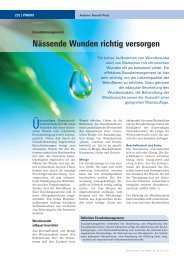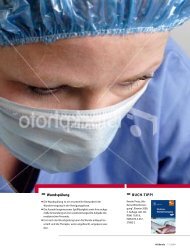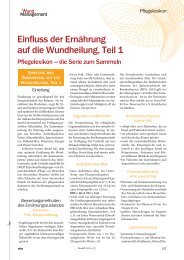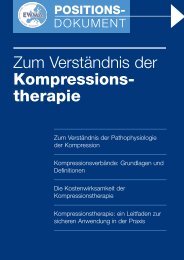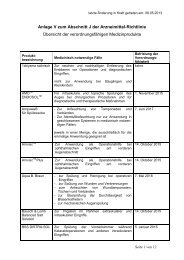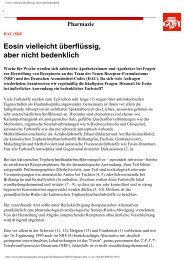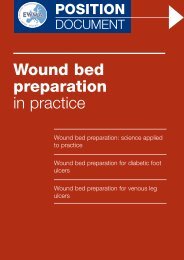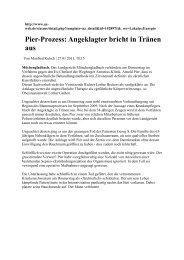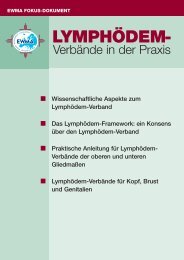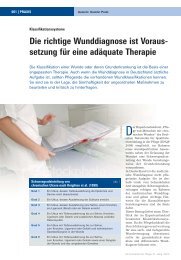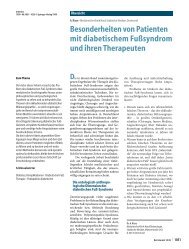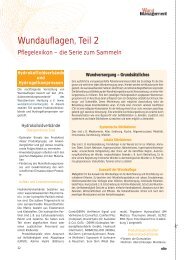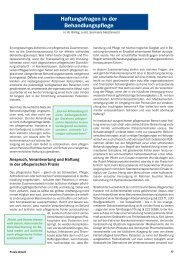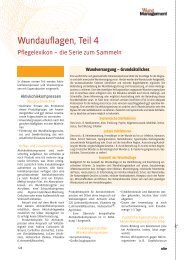Minimising pain at wound dressing-related procedures A ... - Less Pain
Minimising pain at wound dressing-related procedures A ... - Less Pain
Minimising pain at wound dressing-related procedures A ... - Less Pain
You also want an ePaper? Increase the reach of your titles
YUMPU automatically turns print PDFs into web optimized ePapers that Google loves.
CAUSES OF PAIN<br />
USING A LAYERED APPROACH<br />
The terms background, incident, procedural and oper<strong>at</strong>ive can be used to describe the cause<br />
of <strong>pain</strong>. Wh<strong>at</strong>ever the cause of <strong>pain</strong>, the p<strong>at</strong>ient’s experience will be influenced by his/her<br />
psychosocial environment.<br />
Background <strong>pain</strong> is the <strong>pain</strong> felt <strong>at</strong> rest, when no <strong>wound</strong> manipul<strong>at</strong>ion is taking place. It may<br />
be continuous (eg like a toothache) or intermittent (eg like cramp or night-time <strong>pain</strong>).<br />
Background <strong>pain</strong> is rel<strong>at</strong>ed to the underlying cause of the <strong>wound</strong>, local <strong>wound</strong> factors (eg<br />
ischaemia, infection and macer<strong>at</strong>ion) and other rel<strong>at</strong>ed p<strong>at</strong>hologies (eg diabetic neurop<strong>at</strong>hy,<br />
peripheral vascular disease, rheum<strong>at</strong>oid arthritis and derm<strong>at</strong>ological conditions). The p<strong>at</strong>ient<br />
may also have <strong>pain</strong> th<strong>at</strong> is unrel<strong>at</strong>ed to the <strong>wound</strong>, which may impact on the background <strong>pain</strong><br />
experience (eg herpes zoster (shingles), osteoarthritis and cancer).<br />
Incident (breakthrough) <strong>pain</strong> can occur during day-to-day activities such as mobilis<strong>at</strong>ion,<br />
when coughing or following <strong>dressing</strong> slippage.<br />
Causes of <strong>wound</strong><br />
<strong>pain</strong> | Understanding<br />
th<strong>at</strong> there are layers of<br />
<strong>pain</strong> is central to<br />
effective assessment<br />
and management. <strong>Pain</strong><br />
from a clinical<br />
intervention occurs on<br />
top of background <strong>pain</strong><br />
(ie <strong>pain</strong> <strong>at</strong> rest) and<br />
incident <strong>pain</strong> (ie<br />
breakthrough <strong>pain</strong>).<br />
PSYCHOSOCIAL<br />
FACTORS<br />
(eg age, gender,<br />
culture, educ<strong>at</strong>ion,<br />
mental st<strong>at</strong>e –<br />
anxiety,<br />
depression, fear,<br />
loss/grief)<br />
OPERATIVE<br />
(cutting of tissue or prolonged manipul<strong>at</strong>ion<br />
normally requiring anaesthetic, eg debridement,<br />
major burns <strong>dressing</strong>s)<br />
PROCEDURAL<br />
(routine/basic interventions,<br />
eg <strong>dressing</strong> removal, <strong>wound</strong> cleansing,<br />
<strong>dressing</strong> applic<strong>at</strong>ion)<br />
INCIDENT<br />
(movement-rel<strong>at</strong>ed activities, eg friction,<br />
<strong>dressing</strong> slippage, coughing)<br />
ENVIRONMENTAL<br />
FACTORS<br />
(eg timing of<br />
procedure,<br />
setting – level of<br />
noise/positioning<br />
of p<strong>at</strong>ient,<br />
resources)<br />
BACKGROUND<br />
(persistent underlying <strong>pain</strong> due to <strong>wound</strong><br />
aetiology, local <strong>wound</strong> factors,<br />
eg ischaemia, infection)<br />
Procedural <strong>pain</strong> results from a routine, basic procedure such as <strong>dressing</strong> removal, cleansing<br />
or <strong>dressing</strong> applic<strong>at</strong>ion. Non-pharmacological techniques and analgesia may both be required<br />
to manage the <strong>pain</strong>.<br />
Oper<strong>at</strong>ive <strong>pain</strong> is associ<strong>at</strong>ed with any intervention th<strong>at</strong> would normally be performed by a<br />
specialist clinician and require an anaesthetic (local or general) to manage the <strong>pain</strong>.<br />
Psychosocial/environment – factors such as age, gender, educ<strong>at</strong>ional level, environment<br />
and previous <strong>pain</strong> history can all influence p<strong>at</strong>ients’ experience of <strong>pain</strong> and ability to<br />
communic<strong>at</strong>e their <strong>pain</strong>. Clinicians must valid<strong>at</strong>e the <strong>pain</strong> experience and acknowledge the<br />
p<strong>at</strong>ient’s beliefs about the cause of <strong>pain</strong> as well as the potential benefits of different methods of<br />
<strong>pain</strong> management.<br />
2 | PRINCIPLES OF BEST PRACTICE




